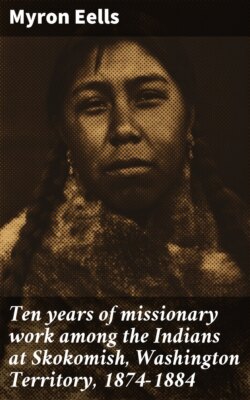Читать книгу Ten years of missionary work among the Indians at Skokomish, Washington Territory, 1874-1884 - Eells Myron - Страница 15
На сайте Литреса книга снята с продажи.
(a) LANGUAGES.
ОглавлениеTable of Contents
ONE great difficulty in the missionary work is the number of languages used by the people. The Clallams have one, the Twanas another; about one sixth of the people on the reservation had originally come from Squaxin, and spoke the Nisqually; the Chinook jargon is an inter-tribal language, which is spoken by nearly all the Indians, except the very old and very young, as far south as Northern California, north into Alaska, west to the Pacific Ocean, and east to Western Idaho. It was made by the early traders, especially the Hudson’s Bay Company, out of Chinook, French, and English words, with a few from several other Indian languages, for use in trade. It serves very well for this purpose, and is almost universally used in intercourse between the whites and Indians. Very few whites, even when married to Indian women, have learned to talk any Indian language except this. But it is not very good for conveying religious instruction. It is too meager. Yet so many different languages were spoken by the seven or eight hundred Indians connected with the agency that it seemed to be the only practicable one, and I learned it. I have learned to preach in it quite easily, and so that the Indians say they understand me quite well. The Twana language would have been quite useful, but it is said to be so difficult to learn that no intelligent Indian advised me to learn it. The Nisqually is said to be much easier, and one educated Indian advised me to learn it, but it did not seem to me to be wise, for while nearly all the Twana Indians understood it, as, in fact, nearly all the Indians on the upper sound do, yet it was spoken by very few on the reservation.
Hence I have often used an interpreter while preaching on the Sabbath at Skokomish, for then usually some whites, old Indians, and children were present who could not understand Chinook. At other times and places I constantly used the Chinook language. But a good interpreter is hard to obtain. “It takes a minister to interpret for a minister,” was said when Mr. Hallenback, the evangelist, went to the Sandwich Islands, and there is much truth in it. The first interpreter I had was good at heart, but he used the Nisqually language. While most of them understood it, yet this person had learned it after he was grown, and spoke it, the Indians said, much like a Dutchman does our language. Another one, a Twana, cut the sentences short, so that one of the school-boys said he could have hardly understood all that I said had he not understood English. A third could do well when he tried, but too many times he felt out of sorts and lazy, and would speak very low and without much life. Hence sometimes I would feel like dismissing all interpreters, and talking in Chinook, but then I was afraid that it would drive away the whites, who could not understand it, but whose presence, for their examples’ sake, I much desired. I feared also that it would drive away the very old ones, who sometimes made much effort to come to church, and also that the children, whose minds were the most susceptible to impressions, would lose all that was said. So there were difficulties every way.
The medley of services and babel of languages of one Sabbath are described as follows: The opening exercises were in English, after which was the sermon, which was delivered in English, but translated into the Nisqually language, and a prayer was offered in the same manner. At the close of the service two infants were baptized in English, when followed the communion service in the same language. At this there were present twelve white members of the Congregational church here, and one Indian; two white members of the Protestant Methodist church; one Cumberland Presbyterian, and one other Congregationalist. There were also present about seventy-five Indians as spectators. The Sabbath-school was held soon after, seventy-five persons being present. First, there were four songs in the Chinook jargon; then three in English, accompanied by an organ and violin. The prayer was in Nisqually, and the lesson was read by all in English, after which the lessons were recited by the scholars. Five classes of Indian children and two of white children were taught in English, and one class partly in English and partly in Chinook jargon. There was one Bible-class of Indian men who understood English, and were taught in that language, a part of whom could read and a part of whom could not, and another of about forty Indians of both sexes whose teacher talked English, but an interpreter translated it into Nisqually; and then they did not reach some Clallam Indians. Next followed a meeting of the Temperance Society, as six persons wished to join it. A white man who could do so, wrote his name, and five Indians who could not, touched the pen while the secretary made their mark. Three of these were sworn in English and two in Chinook. The whole services were interspersed with singing in English and Chinook jargon.
This was soon after I came here. During the past year we have often sung in English, Chinook jargon, Twana, and Nisqually, on the same Sabbath. Another medley Sabbath is given under the head of the Jamestown Church, in connection with its organization.
